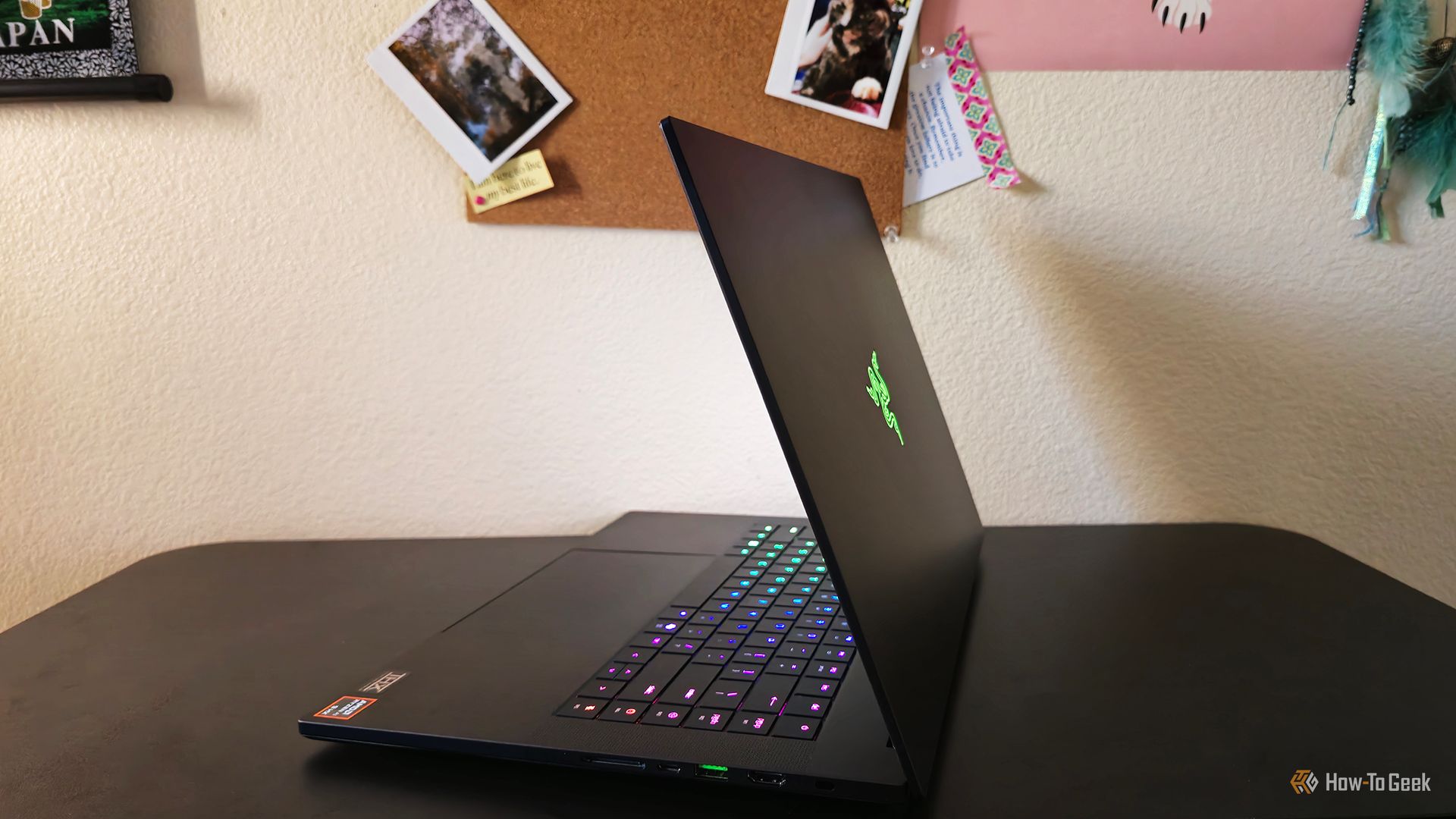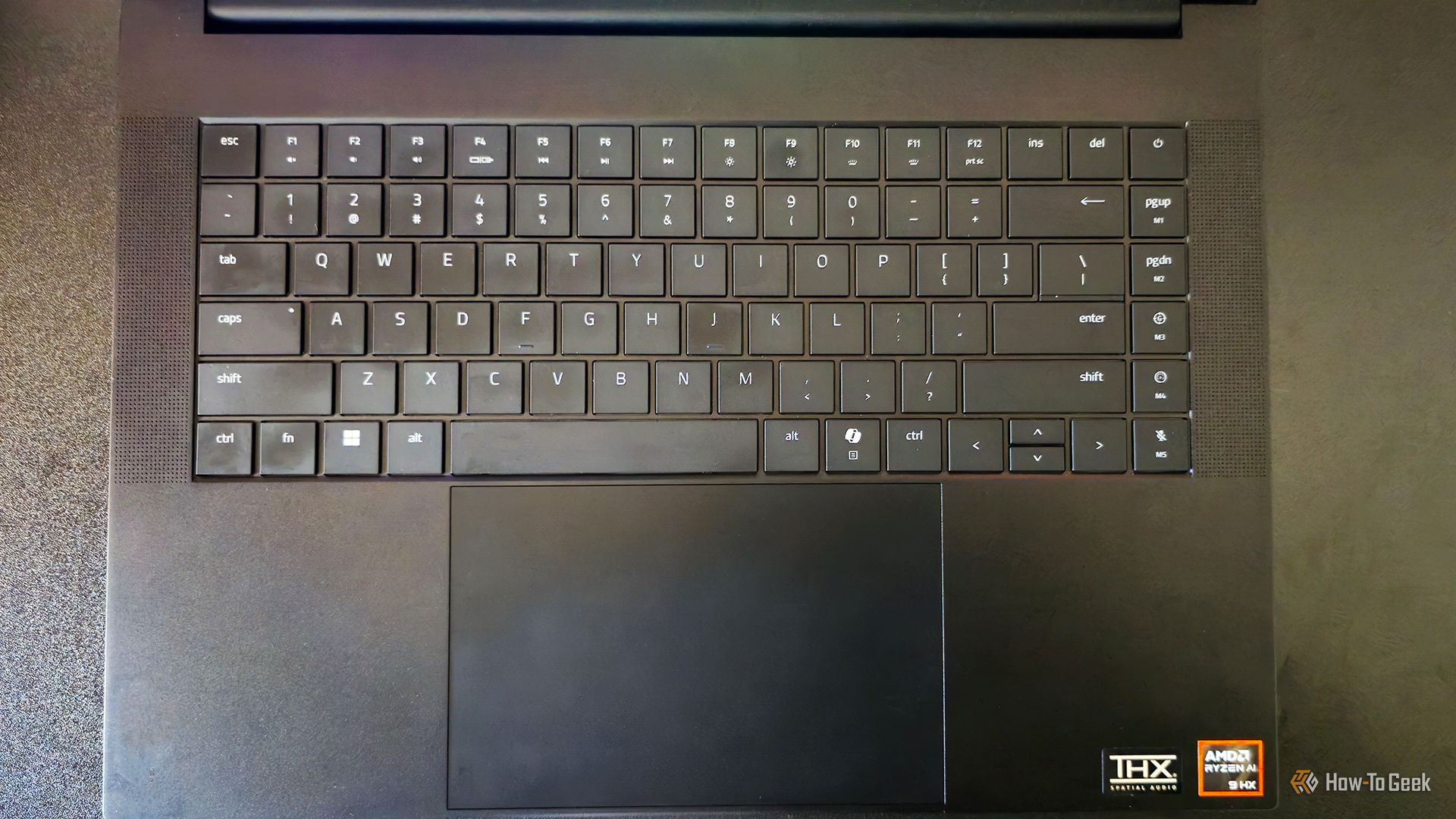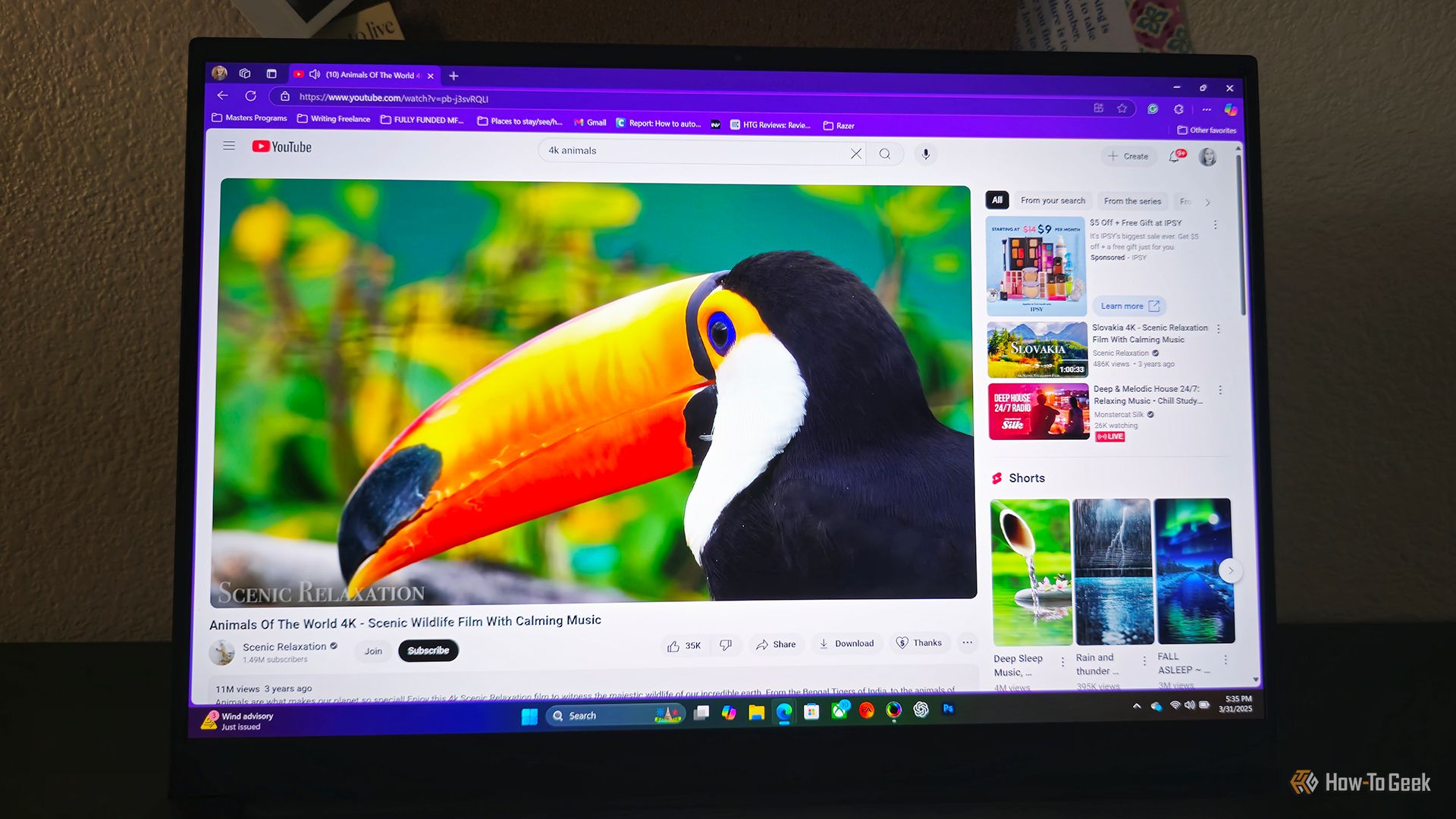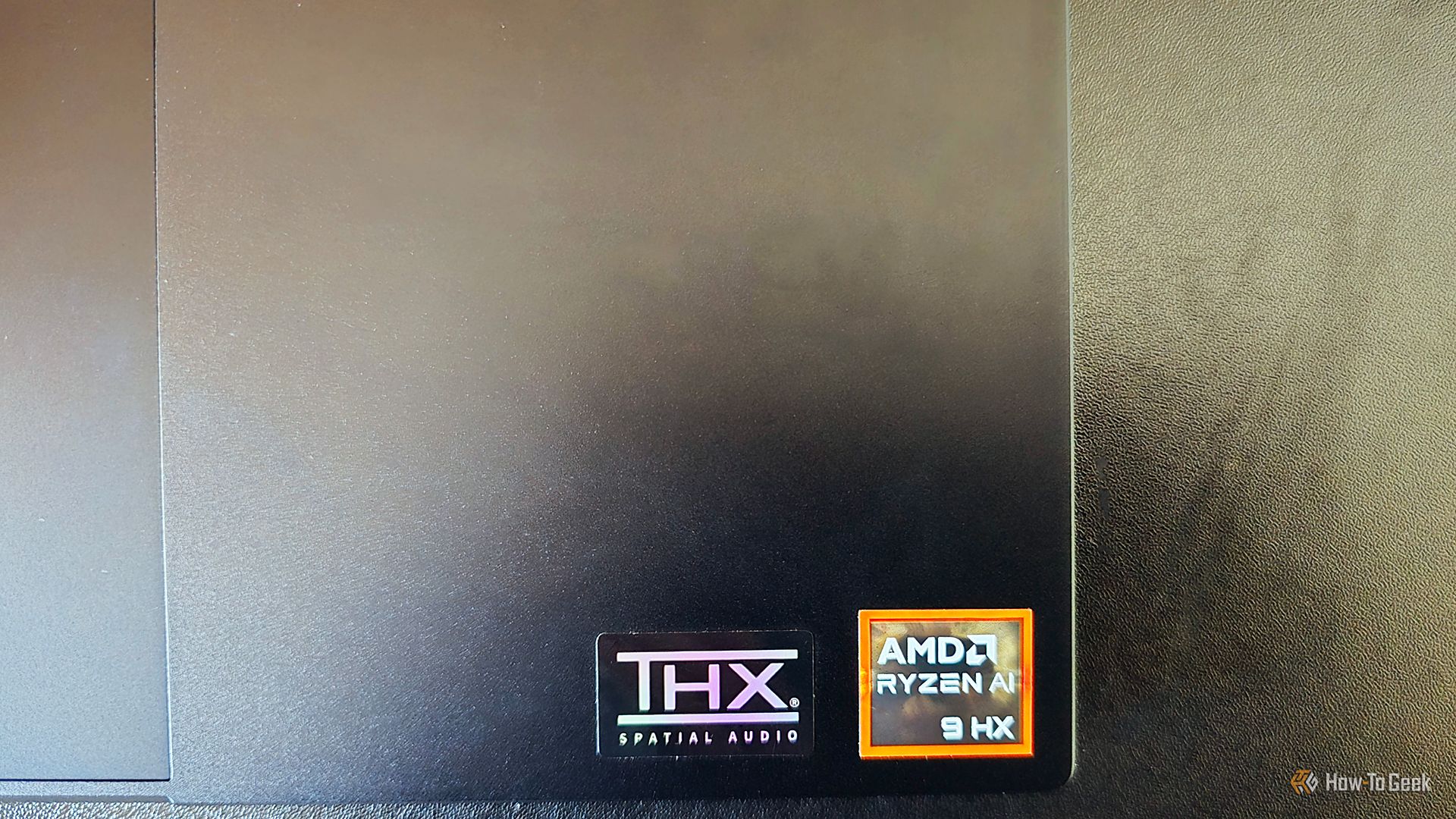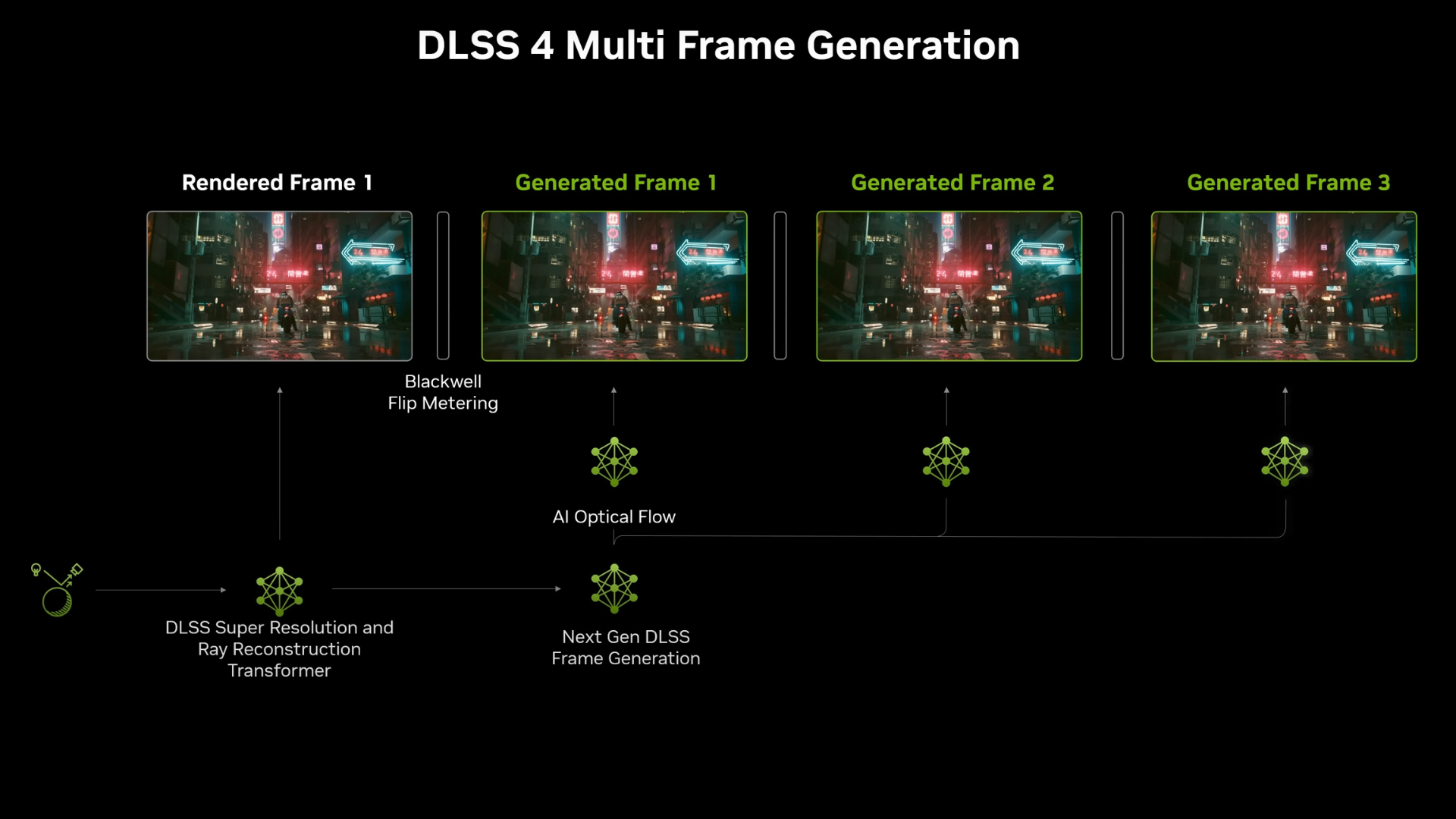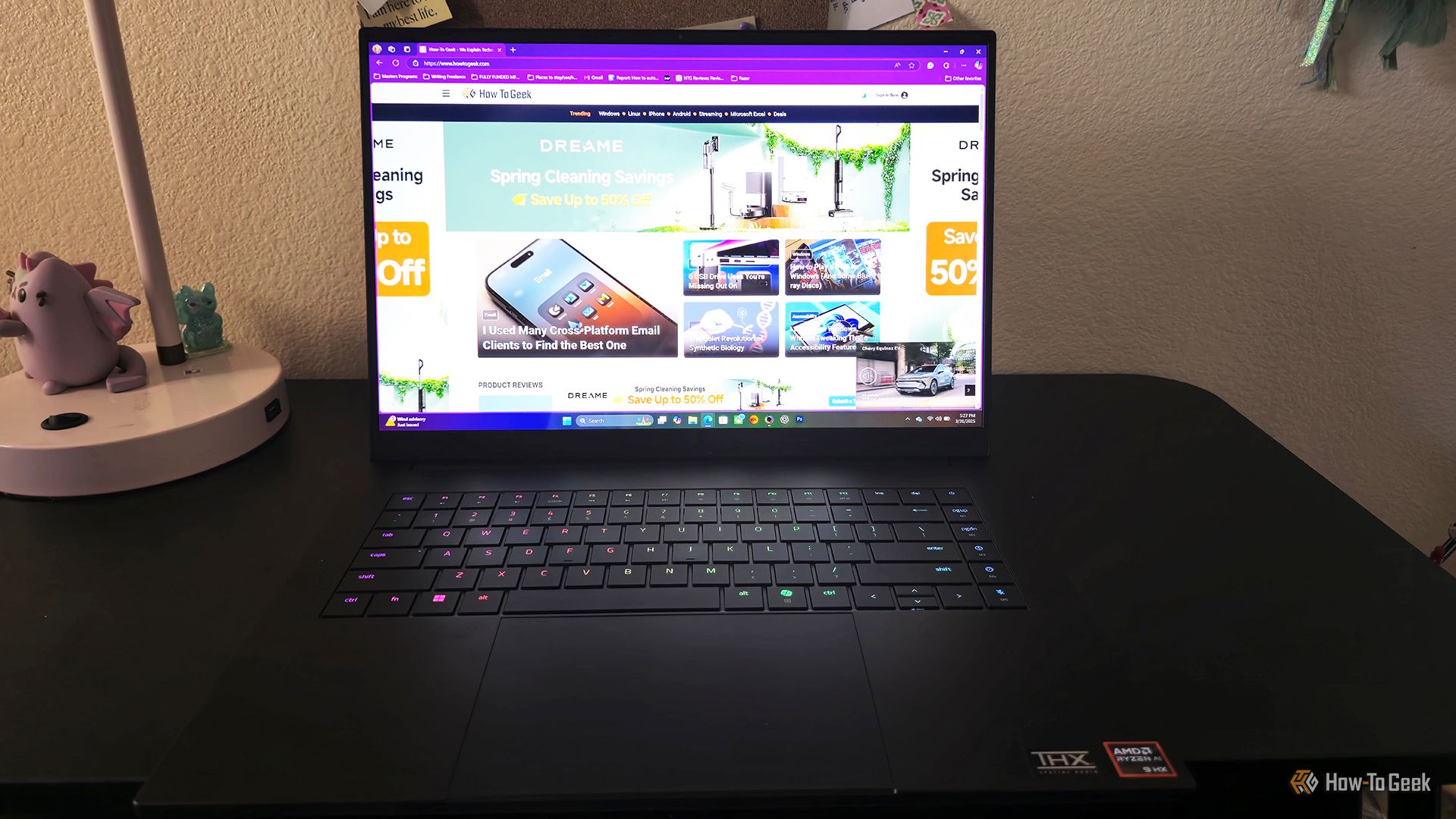Summary
- The Razer Blade (2025) delivers ultra-smooth gameplay with low latency and excellent refresh rates up to 240Hz.
- Its AMD Ryzen 9 CPU and NVIDIA GeForce 5090 GPU combine to create a powerhouse of computing in a slim, portable package.
- A breathtaking 16-inch QHD OLED display features rich, vibrant colors and contrast for captivating graphics.
Enter the thinnest gaming laptop Razer has ever released—and expectations run high. Luckily, the Razer Blade 16 (2025) met my expectations and then some for its gaming power (and overall performance). The latest iteration of the 16-inch Razer combines an AMD Ryzen CPU and an NVIDIA GPU that shines.


Razer Blade 16 (2025)
The Razer Blade 16 (2025) is a powerhouse gaming laptop with Razer’s iconic all-metal chassis, featuring a powerful AMD Ryzen AI 9 HX CPU and an NVIDIA GeForce RTX 5090 GPU. Stunning graphics, high refresh rates, and 24 threads deliver uncompromising visuals and performance for gaming and beyond.
- Smooth gameplay with low-latency and good refresh rates (up to 240Hz)
- Speedy processing that handles resource-heavy games
- Gorgeous OLED display with vibrant color and contrast
- Speaker system is better than most laptops
- Slim enough to travel with
- Gets quite hot despite cooling system
- Fans sometimes overpower speaker system
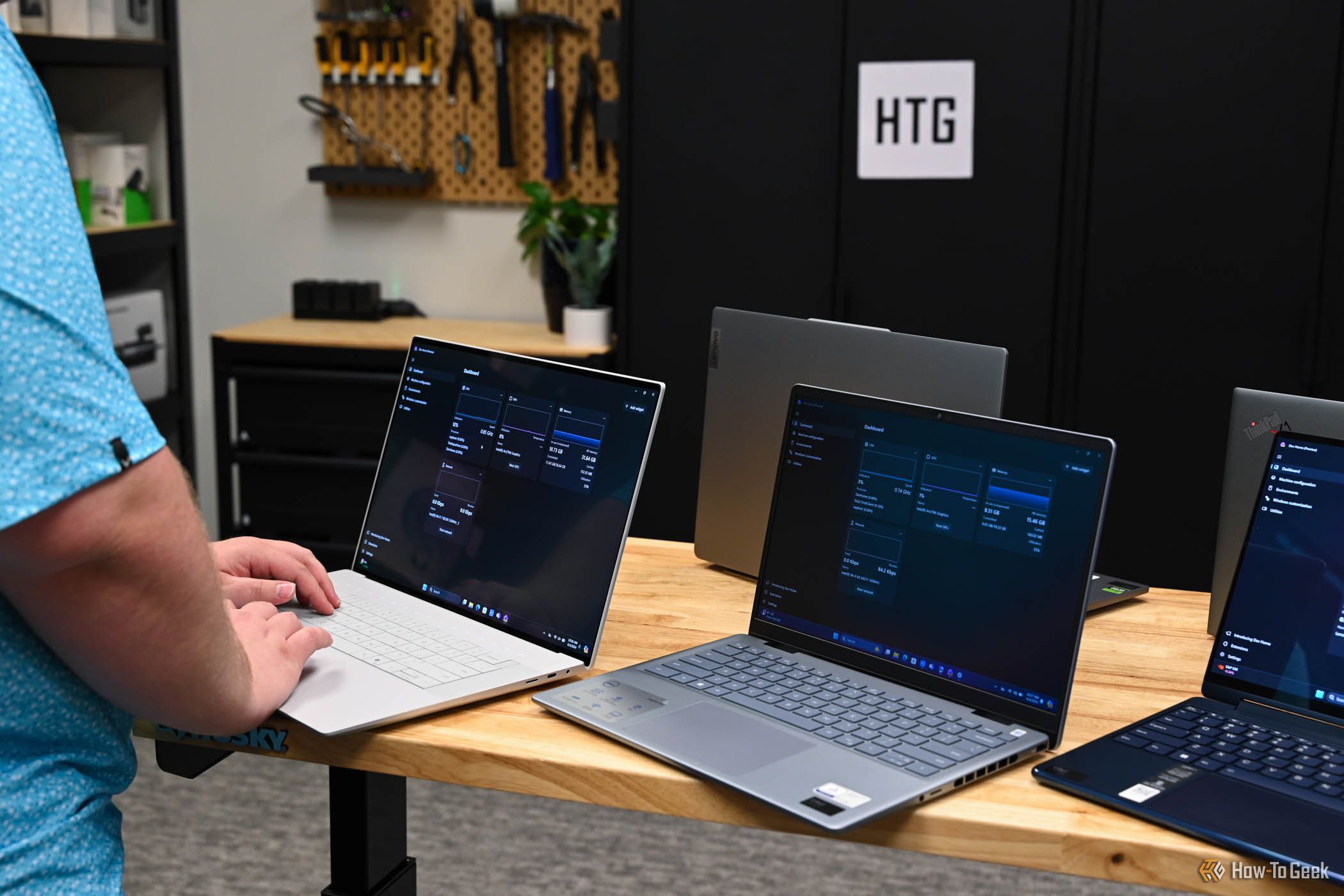
See Our Process
How We Test and Review Products at How-To Geek
We go hands-on with every product to ensure it’s worth your time and money.
Price and Availability
The Razer Blade 16 (2025) is now available for pre-order starting at $2,999 for its base configuration. A PR rep for the company says the first round of pre-orders will be fulfilled shortly (no specifics on dates), but the laptop is currently on pause for pre-orders (TBD) until Razer is ready to take on more. When they launch more pre-orders, the laptop will be available on Razer’s website, Amazon, and other retailers.
My model, the Blade 16 – RZ09-0528, runs for $4,500 for 2TB of storage, 32GB of memory, the AMD Ryzen AI 9 HX 370 CPU, and the NVIDIA GeForce RTX 5090 GPU. The highest configuration runs for $4,900 for 64GB, 4TB of storage, the 5090 GPU, and the HX 370 CPU.
The Thinnest Razer Gaming Laptop Ever
Anyone who has followed Razer will know their gaming laptops are hefty—any gaming laptop is, for that matter. But Razer took on the challenge of creating a thinner version of its Blade 16, resulting in a more portable option for gamers who want to bring their baby with them. And I say they achieved it. Don’t get me wrong, there’s still significant heft to the Blade 16 (2025)—approximately 4.6 pounds. But that feels much more portable than the Razer Blade 16 (2024), which came in at 5.4 pounds, or the Razer Blade 18 (2023), a whopping 7 pounds.
I confidently affirm that I would feel comfortable bringing the latest Blade 16 with me on a weekend trip, as I did just that for a friend’s bachelorette. It fit inside my travel backpack and didn’t feel so massive that I was uncomfortable lugging it around. That test made me feel even more confident that, should I want to get on a plane with the Razer, I’d be fine. I’ve previously dragged my Lenovo Legion Pro 5i Gen 8 gaming laptop (5.1 pounds) on flights to Texas and back, which felt much heavier to me than the Blade 16—that half a pound makes a difference!
As for its overall look, the Blade 16 (2025) continues the legacy of its solidly built, beautiful matte black aluminum chassis, per-key customizable RGB keyboard, and backlit Razer logo on the back. Compared to the Razer Blade 16 (2024) ’s 0.86-inch base, the Blade 16 (2025) reaches as thin as 0.59 inches. Its slimmer design affects its power, as this model reaches a max of 160W, while the 2024 iteration could reach up to 175W on its RTX 4090. If you really care about those extra 15W, you might want to stick with a heftier gaming laptop.
Ports Aplenty
Despite its slimmed-down size, the Razer Blade 16 (2025) still has all the ports you’ll need to work, game, and connect.
On the left side is a power port for charging, two 3.2 Gen USB-A ports, one USB-C port, and a 3.5mm combo jack.
The laptop’s right side houses a UHS-II SD card reader, another USB-C port, another USB-A port, an HDMI 2.1 port, and a Kensington lock.
The back of the laptop is free of ports.
An Upgraded Keyboard and Large, Responsive Touchpad
A bone of contention with Razer owners has been their keyboards. In fact, when I reviewed the Razer Blade 18 (2023), I was stymied by its compact size. Previous iterations felt too awkward to type on comfortably. Luckily, Razer listened to the feedback. The brand upgraded the keyboard on the Blade 16 (2025), adding about a quarter of an inch in space. It felt so much more comfortable to type on that I almost forgot about my past qualms, and I could comfortably use the keyboard while gaming without feeling like I needed to plug in my Keychron Q6 Pro for more space.
I noticed this upgraded keyboard felt more responsive (and took less work to push down the keys). That’s because they increased key travel by 50%, giving the Blade 16’s keyboard a 1.5mm travel. It also had a 63G actuation force, which meant I could speedily type and avoid (mostly) hitting keys I didn’t wish to. Occasionally, I made clumsy typing mistakes, but I won’t blame the keyboard for those. According to a word-per-minute test, I could comfortably type anywhere from 70 to 80 words per minute with about 97% accuracy.
As with Razer’s other gaming laptops, the Blade 16 (2025) had customizable per-key RBG lighting, which I could tweak in the pre-installed Chroma app (available on Windows 10 and 11). Customizing the keyboard was easy—I could choose from 8 preset light effects or head to the “Studio” tab to select various colors or effects for each keyboard key.
The Blade 16’s glass touchpad had a matte surface but felt smooth enough that my fingers didn’t catch during important portions of games when my fingers were getting sweaty. It was larger than regular laptop touchpads, measuring approximately 5.9 by 3.8 inches.
t performed well with light taps but also had a clickable surface area that didn’t stick and felt pleasant whether I was working in Photoshop, browsing the web, or gaming. It was very responsive, but I didn’t find my wrist brushing it as I typed or gamed, which was a plus for anyone who gets lazy, tired wrists after long-term computer use.
Ultra-Clear Display and Graphics With Rich Contrast
Gaming, streaming, editing photos, or watching YouTube videos felt like an experience on the Razer Blade 16. Its glossy, 16-inch OLED has a resolution of 2,560 by 1,600p and delivers some truly outstanding visuals at nearly any brightness. I preferred to keep the brightness at around 50% or higher to enjoy the full depth of color and contrast.
Because it was an OLED, darker colors and black looked true to shade, providing a depth that other non-OLED screens often lack. Its Calman-verified color profiles include sRGB, Adobe RGB, DCI-P3, and Rec.709, which could be helpful for content creators.
No matter what media I was consuming, I got crisp, rich graphics with a contrast that, quite frankly, blew my mind compared to some of the other laptop displays I’ve seen in the past six months. The screen was also rated for ClearMR 10000, which provided clarity and sharp details while moving in games. While running or undergoing stealth tasks in games, I felt the graphics looked crisper than I’m used to seeing on gaming laptops (a big, big win for gamers).
Black colors popped well against vibrant reds and blues in The Avengers, while actors like Scarlett Johansson and Mark Ruffalo looked so dang clear I felt like I could reach out and touch them through the screen. Similarly, the depth of color and contrast shone when watching wildlife videos. For instance, a toucan’s colorful beak popped against greenery, and its black feathers had the blue undertones many black shades have.
As a weird caveat, for some reason, all of Razer’s default display settings on Windows make everything look tiny compared to other standard laptop displays (i.e., app icons, web browser windows, etc.) The text was so hard to read that I altered the display settings to scale at 150% (rather than the recommended 125%). It doesn’t look like an equal scale to other PCs, and I’m not sure why this is a thing. But it irked me. (And probably won’t bug anyone else since it’s an easy fix?) But it’s worth noting that you might want to tweak the scale if you grab one for yourself.
AMD’s Ryzan AI 9 HX 370 and the RTX 5090
I admit I was a bit skeptical about Razer switching over to an AMD processor because I tend to prefer Intel CPUs. That said, the AMD Ryzen AI 9 HX 370 performed quite well and made me feel like I could (almost) convert. The CPU boasts AI integration with Copilot+, bringing up to 50 TOPS for AI tasks. The Blade 16 features all the Copilot+ experiences you could want, including Cocreator in Paint, Live Caption for videos, and AI Recall to easily find what you’re looking for.
Aside from the AI features, the HX 370 offers 12 cores and 24 threads that can tackle plenty of resource-heavy processing. And I found that coupled with the 32GB of RAM, often gave me more power than I needed. This is, however, somewhat of a downgrade from the Blade 16 (2024), which had an Intel Core i9-14900HX CPU with 24 cores and 32 threads—a powerhouse that will undeniably be a bit speedier for multicore work. That processor also outperforms the Ryzen HX 370 in benchmarks for single and multicore performance.
I can attest to this, as my gaming laptop has an Intel Core i9-13900 HX CPU (24 cores, 32 threads), which felt a lot faster to me than the HX 370 for some multitasking (multicore) work (a little more on this later).
Onto the NVIDIA 5090 GPU—it kills it. The new Blackwell architecture in RTX 50 series laptops like this has twice the efficiency and performance as previous generations, and I did feel the difference in terms of overall speed. It hits up to 160W total graphics power (less power than the last iteration of the Blade, as previously mentioned). I didn’t notice that this severely affected gaming performance, and it may be worth it for the slimmer frame if you want a portable gaming laptop.
The GPU has all the NVIDIA stuff you’d hope for, including NVIDIA G-Sync (which prevents screen tearing tearing) and DLSS 4 for faster frame generation. DLSS 4 includes NVIDIA’s Super Resolution, Ray-Reconstruction, and a new AI-Transformer Model as well as multi-frame generation.
Powerful Performance For Most Tasks
Some of my browser pages and programs lagged slightly when using the “Balanced Mode” power plan. There was about a half-second delay when closing tabs or trying to open programs. When I switched to “Best Performance,” the laptop ran much smoother, but it depended on how much multitasking I was trying to do.
Pushing the CPU to its limits, I had YouTube running, 20 browser tabs, a game running in the background, the Xbox app open, and I edited photos in Photoshop. This severely slowed down the laptop, but most people would never attempt to run these combinations of programs in one go; I wanted to see how far I could take it. After closing a video game, I still struggled with speed, so I closed out Xbox, YouTube, the Chroma app, and a couple more browser tabs. This lightened the load enough to speedily edit those photos in Photoshop.
The Razer Blade 16 (2025) managed to breeze through tasks for my daily workload despite those small delays and mostly felt speedy. My workload often involved multiple browser tabs, word processing programs, and Spotify for music.
I did experience some slow processing for Photoshop compared to other laptops I’ve tested. I rebooted the laptop once to try to remedy this. This didn’t make it that much faster. So, I checked to see if the PC was throttling down due to temperature or bandwidth and found that it was a bandwidth issue. Photoshop performed best when no other programs were open, and even the slow delay was a minuscule half-second to a second between clicks. Nothing too crazy to override the overall fantastic performance of the CPU.
As for the Blade 16’s cooling system, it features a new thermal hood design, dual fans, a vapor chamber cooling solution, and .05mm exhaust fins. I found the cooling system’s performance effective (I only saw the CPU and GPU hit about 80 degrees Celsius or so after long gaming sessions).
When pushed to the limit or plugged in while gaming, the laptop feels quite hot, and the fans kick up noisily. But this is nothing I’m not used to on gaming laptops, and the ventilation performs well enough to keep the laptop protected from overheating.
Gaming Performance: It’s Worth The Hype
Gaming on the Razer Blade 16 (2025) was so enjoyable that I played for longer than planned. Once, I was up till 4:30 a.m. because I lost track of time. Oops!
DLSS 4 offered multi-frame generation for plenty of games, making my gaming experience smooth as butter. For instance, when I played Avowed and Dragon Age: The Veilguard, all my graphics settings were on high or epic, and there was no latency to speak of, no screen-tearing, and smooth, crisp frame generation that made it easy to get lost in the games.
Testing Indiana Jones and the Great Circle, I had a wonderfully responsive experience on graphics set to high and ultra. During gameplay, I monitored the frames per second (FPS) and found full ray tracing still provided a 55-60fps average. When I turned off the optional ray-tracing settings, my game hit a ballpark of 80 to 100fps.
Atomfall was also incredibly smooth to play with graphics on medium (60fps average) with a 9 to 14% CPU and 65% GPU load.
Another impressive performance came from Cyberpunk 2077, which I played on the Blade 16 on battery power. Still, with graphics settings on high and ultra, ray tracing on low, and DLSS on auto, I noted around 60fps.
With this smooth experience for all the above games, I could engage in combat without any issues and game to a near-competitive level if I so wished. I would recommend that really competitive gamers turn the graphics settings down slightly for higher FPS, as that’s when I hit those 80 to 100fps marks. But overall, many medium- to high-resource games played fantastically well for me on the Blade 16, and the power is enough to please gamers who don’t already have a more powerful GPU. Razer hyped this as a “significant upgrade for gamers using an RTX 30 Series or lower,” and I agree.
The Speakers, Camera, and Microphones Perform Well
For laptop speakers, the six woofers and tweeters (up and down-firing) on the Razer Blade 16 provide decent sound quality. Like most laptop speakers, though, I would still say they are better than headphones. Nonetheless, I could enjoy most media on the speaker system.
During games, the speakers put out immersive, well-mixed sound with a good balance of lows, mids, and highs. Movies like Disney’s Alice in Wonderland and The Avengers also sounded fairly well-balanced (though the bass could still be heavier).
I also enjoyed listening to music on the Blade 16. Sleep Token’s Euclid, for example, sounded quite nice at 50 to 65%. I was impressed that, even above 75% volume, most of the tracks still sounded great. However, there was a noticeable grating sound when the guitars kicked in at this level, which made me turn the volume back down. Similarly, Gary Jules’ Mad World sounded awesome, even at 70%. But when I passed that volume threshold, the piano was too bright, overpowering the rest of the mix and affecting my listening experience.
Razer’s Synapse app (Windows only unless using Razer Synapse 2) allowed me to customize listening profiles, which was a nice touch for getting the sound I wanted.
Overall, I thought the speaker system was above average for a laptop and performed well. My only comment is that when I was gaming (plugged in) and the fans kicked up, I desperately wanted headphones. The intensive cooling system helps the laptop function to its best performance without overheating, but believe me—the fans are loud. With the volume at 100%, I could still hear them, and it was difficult to hear the audio above the racket.
The Blade 16’s IR FHD webcam was about average performance to slightly above. It did above average in dim lighting scenarios and didn’t overexpose or over-saturate my skin tone as some other cameras do.
It’s not the best webcam I’ve ever seen, but it provides crisp, clear images and video that most people would be happy with.
In some instances, the dual-array microphones did quite an impressive job with noise cancelation. Even when playing background music and in a noisy environment, the mics picked up my voice, which stayed pleasantly at the forefront. Although there was a slight warble in the audio, I was still pleased with this performance, as at one point, I held a speaker playing music right up to the mics and could still hear myself speaking in the recordings.
Microphone Test on the Razer Blade 16 (2025) Gaming Laptop in a Noisy Environment
Microphone Test on the Razer Blade 16 (2025) Gaming Laptop in a Quiet Environment
Decent Battery Life… For a Gaming Laptop
I didn’t expect much from the battery since this is a gaming laptop, but the Razer Blade 16 managed to drain at a relatively okay pace for this type of device. Its average drain time was about 0.37% per minute for most purposes besides gaming. That was about four and a half hours before I needed to plug in. Considering I’ve seen gaming laptops hog a full battery in about two and a half to three hours, this was a good performance. It did drain about as quickly when left on sleep, though, at about 0.28 to 0.3% per idle minute.
Gaming on battery power, as expected, was another story. It lost juice at an average rate of 1.35% per minute, which got me about an hour and 14 minutes of gameplay before I needed to recharge.
Charging speed was an average of 1.06% per minute, so a full charge took about one hour and 34 minutes—not a bad rate if you aren’t gaming on the thing all day. And if you are, I’d recommend staying plugged in as much as possible.
Should You Buy the Razer Blade 16 (2025) Laptop?
The biggest thing getting in the way of someone committing to the Razer Blade 16 (2025) is likely the price. With the lowest configuration retailing for $3,000, this model is a significant investment. And my particular configuration was around $4,500. The investment, though costly, does provide you with a very high-performing gaming laptop that can handle just about anything. Still, it has limitations, like fewer threads than some other highly ranked gaming laptops for pro-level multitasking (the Alienware m18 R2, for example, has a model with an Intel Core i9 14900HX with 32 threads) or its 160W max power, thanks to its slimmer design.
Still, I found little to dislike about the latest Razer Blade 16, and I think most gamers would be elated to have it in their arsenal.


Razer Blade 16 (2025)
The Razer Blade 16 (2025) is a powerhouse gaming laptop with Razer’s iconic all-metal chassis, featuring a powerful AMD Ryzen AI 9 HX CPU and an NVIDIA GeForce RTX 5090 GPU. Stunning graphics, high refresh rates, and 24 threads deliver uncompromising visuals and performance for gaming and beyond.

